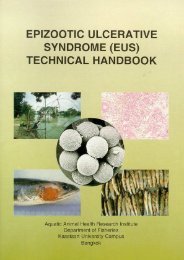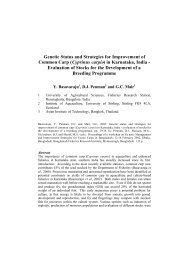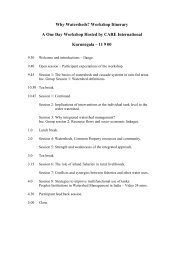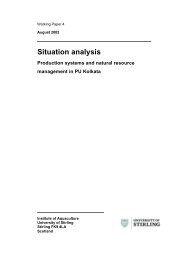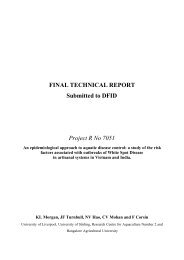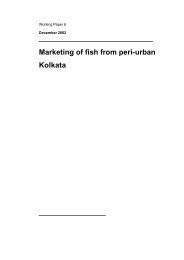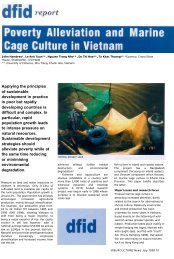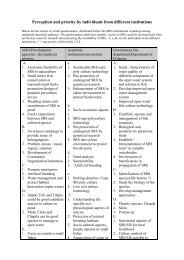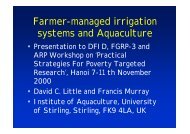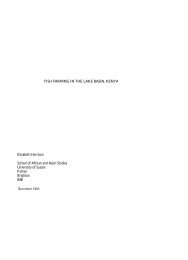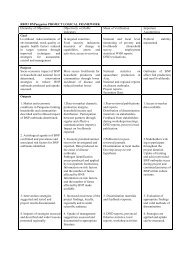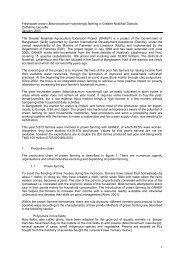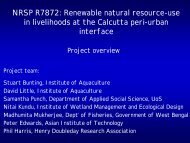Conservation of Fish Genetic Diversity: Need for ... - DFID@Stir
Conservation of Fish Genetic Diversity: Need for ... - DFID@Stir
Conservation of Fish Genetic Diversity: Need for ... - DFID@Stir
You also want an ePaper? Increase the reach of your titles
YUMPU automatically turns print PDFs into web optimized ePapers that Google loves.
<strong>Conservation</strong> <strong>of</strong> <strong>Fish</strong> <strong>Genetic</strong> <strong>Diversity</strong>: <strong>Need</strong> <strong>for</strong><br />
Development <strong>of</strong> a Cryogenic Genebank in Bangladesh<br />
A. Bart<br />
Aquaculture and Aquatic Resources Management, Asian Institute <strong>of</strong><br />
Technology, Bangkok, Thailand<br />
Bart, A. 2002. <strong>Conservation</strong> <strong>of</strong> fish genetic diversity: need <strong>for</strong> development <strong>of</strong> a cryogenic<br />
genebank in Bangladesh. pp. 107-110. In: Penman, D.J., Hussain, M.G., McAndrew, B.J. and<br />
Mazid, M.A. (eds.). Proceedings <strong>of</strong> a workshop on <strong>Genetic</strong> Management and Improvement<br />
Strategies <strong>for</strong> Exotic Carps in Asia, 12-14 February 2002, Dhaka, Bangladesh. Bangladesh<br />
<strong>Fish</strong>eries Research Institute, Mymensingh, Bangladesh. xxx p.<br />
Background<br />
Bangladesh is ranked 3 rd<br />
largest in aquatic biodiversity in Asia behind China and<br />
India, with approximately 300 species <strong>of</strong> fresh and brackish water fish species<br />
(Hussain and Mazid, 2001). This species diversity has been attributed to one <strong>of</strong> the<br />
world’s largest wetlands (Bengal Delta) and three large river systems (Brahmaputra,<br />
Ganges and Jamuna) that flow from the Himalayan mountains into the Bay <strong>of</strong><br />
Bengal. Enormous freshwater fisheries resources feed millions <strong>of</strong> people living in<br />
the Delta. Recent acceleration <strong>of</strong> aquaculture production (700,000 tons <strong>of</strong> fish) in<br />
Bangladesh has begun to relieve fishing pressure from a few large rivers and water<br />
bodies. It is expected that the consumption demand <strong>for</strong> fish will reach over 2 million<br />
tons by the year 2002 (DoF, 1999). Un<strong>for</strong>tunately, overharvesting <strong>of</strong> fish with an<br />
increasing fishing population is likely to continue and place greater pressure on most<br />
small and large size water bodies. Rapid extraction <strong>of</strong> seed (<strong>for</strong> stocking) as well as<br />
broodfish (<strong>for</strong> seed production and consumption) from natural waters combined with<br />
destructive and unregulated fishing practices that use dynamite, cyanide,<br />
electr<strong>of</strong>ishing and gillnets has led to the endangerment and possibly extinction <strong>of</strong> a<br />
number <strong>of</strong> rather valuable native species (Hussain and Mazid, 2001).<br />
Loss <strong>of</strong> aquatic habitat due to siltation, dam construction (<strong>for</strong> irrigation, flood control<br />
and hydroelectric generation), and other anthropogenic activities has been one <strong>of</strong> the<br />
primary causes <strong>of</strong> species loss. Siltation in the upstream reduces water flow and<br />
water depth, impairing the opportunity <strong>of</strong> riverine fish to feed, navigate, and migrate
Bart, A.<br />
and spawn. Construction <strong>of</strong> embankments <strong>for</strong> flood control and dams interferes<br />
directly or indirectly with fish migration, reproduction and ultimately survival <strong>of</strong><br />
species. Deepening <strong>of</strong> channels by removing silt is a temporary and costly solution<br />
to improve habitat. While long term and effective measures are being sought, more<br />
effective and immediate measures are needed to protect and conserve threatened and<br />
endangered species.<br />
Aquaculture practices (domestication, typical genetic manipulation: selection, sex<br />
reversal, hybridization and crossbreeding) and release <strong>of</strong> fry into natural water bodies<br />
also contribute to indigenous species degradation. The decade -long practice <strong>of</strong><br />
stocking exotic and indigenous carp seed in the rivers and reservoirs already makes it<br />
difficult to determine the negative impact resulting from gene introgression and<br />
inbreeding. In other words, indigenous species in nature are probably contaminated<br />
to a level where it becomes difficult to compare per<strong>for</strong>mance against hatchery stock.<br />
While little can be done to bring back lost species <strong>of</strong> Bangladesh, currently 56<br />
species <strong>of</strong> freshwater species including 11 cyprinids are endangered or near<br />
extinction (IUCN, 1998), needing immediate measures to protect and conserve them.<br />
Establishment <strong>of</strong> ex situ gene banks, live and/or cryogenic, in the immediate term<br />
would ensure the maintenance <strong>of</strong> genetically pure stocks <strong>of</strong> fish while “buying us the<br />
time” necessary to improve habitat conditions <strong>for</strong> restocking.<br />
Ex situ Preservation and its Importance to Bangladesh<br />
The ideal strategy <strong>for</strong> conservation <strong>of</strong> threatened and endangered species is through<br />
in situ (conservation <strong>of</strong> the ecosystem or habitat to maintain them in their natural<br />
environment) protection/restoration <strong>of</strong> the native habitat <strong>of</strong> the species.<br />
Un<strong>for</strong>tunately, this is costly and requires a great deal <strong>of</strong> time as habitat restoration is<br />
clearly a slow process. One alternative is to maintain ex situ (conservation outside<br />
their natural environment) live or cryopreserved gene banks. Live gene banks <strong>for</strong><br />
fish are also costly, requiring purpose built facilities, and being labor intensive are<br />
difficult to manage. Past attempts to maintain long-term live gene banks have <strong>of</strong>ten<br />
resulted in contamination <strong>of</strong> stocks.<br />
There are fewer constraints to the establishment <strong>of</strong> long-term ex situ frozen gene<br />
banks, which are thought to ideally complement habitat conservation and in situ gene<br />
banks (Bart, 2001). There are several examples <strong>of</strong> cryogenic sperm banks <strong>for</strong> fish in<br />
Europe, and North and South America. They are comparatively less costly than live<br />
gene banks although some initial investment <strong>for</strong> equipment, maintenance and<br />
collection would be required. Cryogenic gene banking avoids the risk <strong>of</strong><br />
contamination and requires little space and minimal facilities. While<br />
108
Cryogenic genebanking<br />
cryopreservation <strong>of</strong> sperm has been successful <strong>for</strong> many species, and the protocols<br />
have been well developed, cryopreservation <strong>of</strong> eggs and embryos has been successful<br />
only in oysters. Research into teleost egg and embryo is on going (Bart, 2000).<br />
Furthermore, it is possible to recover genotypes from cryopreserved sperm using<br />
androgenesis to produce viable diploid organisms with paternal only inheritance.<br />
Ex situ conservation via cryopreservation has many potential practical applications.<br />
For example, maturation <strong>of</strong> males and females in a number <strong>of</strong> species is<br />
asynchronous. Bighead carp females come to seasonal maturity when sperm from<br />
males is not available. Hatchery producers <strong>of</strong> Bangladesh <strong>of</strong>ten use sperm from<br />
another species such as silver carp, which is less desirable as indicated by the lower<br />
price <strong>of</strong> this hybrid. Maintaining sperm in cold storage would facilitate artificial<br />
fertilization and subsequent seed production.<br />
Many species <strong>of</strong> surviving brood animals have reached critically low levels, and this<br />
is likely to cause irreversible genetic bottlenecks in Bangladesh. Examples <strong>of</strong> these<br />
species in Bangladesh include 11 species <strong>of</strong> carps and barbs (Hussain and Mazid,<br />
2001). Cryogenic preservation <strong>of</strong> sperm could facilitate dramatic increase in the<br />
effective breeding population in future restoration ef<strong>for</strong>ts.<br />
Conclusions and Recommendations<br />
Clearly, a cryogenic sperm bank has application to both aquaculture and conservation<br />
<strong>of</strong> species in Bangladesh. The Bangladesh <strong>Fish</strong>eries Research Institute (BFRI) has<br />
been charged with collection <strong>of</strong> indigenous species <strong>for</strong> propagation purposes. It has<br />
the necessary facilities, and pond and tank space to house a number <strong>of</strong> species and<br />
could naturally assume the responsibility <strong>of</strong> collection <strong>of</strong> samples from priority<br />
species, and the mainte nance <strong>of</strong> collections and a database. Having established such<br />
a facility, it could join <strong>for</strong>ces with academic institutions, the DoF and/or local NGOs<br />
such as BRAC to facilitate the education and training <strong>of</strong> hatchery operators and<br />
technicians on the use and distribution <strong>of</strong> cryopreserved sperm <strong>for</strong> hatchery use<br />
purposes.<br />
References<br />
Bart, A.N. 2000. New Approaches in Cryopreservation <strong>of</strong> <strong>Fish</strong> Embryos, In:<br />
Cryopreservation in Aquatic Species. Tiersch, T.R. and P.M. Mazik, Editors.<br />
World Aquaculture Society, Baton Rouge, Louisiana. Pp. 179-187.<br />
Bart, A. N. 1999. Biodiversity and Ex Situ <strong>Fish</strong> <strong>Genetic</strong> <strong>Conservation</strong>. AARM<br />
Newsletter. Vol. 4(4) 6-8.<br />
DoF. 1999. A Brief on Department <strong>of</strong> <strong>Fish</strong>eries, Bangladesh. DoF, Dhaka.<br />
109
Bart, A.<br />
Hussain, M.G. and M.A. Mazid. 2001. <strong>Genetic</strong> Improvement and <strong>Conservation</strong> <strong>of</strong><br />
Carp Species in Bangladesh. BFRI and ICLARM publication, Dhaka,<br />
Bangladesh.<br />
IUCN Bangladesh. 1998. List <strong>of</strong> Threatened Animals <strong>of</strong> Bangladesh. Paper<br />
Presented in the Special Workshop on Bangladesh Red Book <strong>of</strong> Threatened<br />
Animals, 22 February 1998. Dhaka.<br />
110




